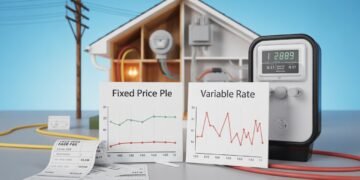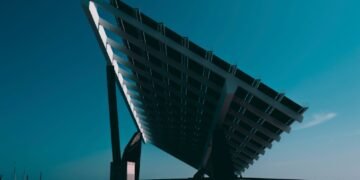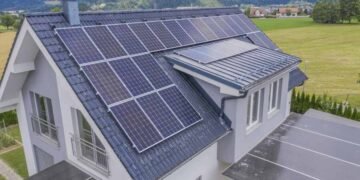Nothing beats watching TV with a cool drink from the fridge in hand; solar energy allows you to do that. You can avoid living in the dark during a blackout by using solar energy to supply your television and lighting power. Solar energy may help you minimise your carbon impact and electricity expense.
But how many solar panels for lights and tv simultaneously? Without a doubt, it is conceivable, but how many panels are needed? Do you require batteries?
A TV requires at least 500-watt solar panels and 200-ampere-hour batteries. A 120-watt solar panel, on the other hand, can power a 50-inch LED TV for 2 to 3 hours.
How to Use Solar Panels for TV
When it comes to television and Lighting, you’ll need to know how much power they consume to offer the appropriate electricity to these gadgets properly. We’ll also show you how to calculate how much TV and illumination can cost you in terms of utility costs.
Solar panels can power a whole house, so if you have enough meetings, you won’t have to worry about not obtaining enough electricity from your system.
Also Read: A Short Guide for Solar PV Installation In Brighton Houses
How Much Energy Does Television Consume?
To put things into perspective, a TV’s wattage is not the same as its power use. Wattage only provides a rough estimate of your TV’s energy consumption; you will need to perform further calculations to discover how much of your energy bill is consumed by TV usage.
On average, assume you watch TV for six hours daily, and your LED TV consumes 50 watts of power.
This equates to daily use of 300 watt-hours. It is unreasonable for you to watch TV for six hours every day, but if you did, by the end of the month (i.e., 30 days), you would have consumed 30 x 300 = 9000 watt-hours. Using a straightforward calculation of cents per kilowatt-hour amounts to the monthly energy use of 9 kWh.
Taking a ballpark figure, the US Energy Information Administration sets kWh power costs for US citizens at 12 cents per kWh. This means that using the TV, as shown above, will only cost you roughly $1 each month.
This cost would be higher if you had more than one TV or if you left the TV on for longer periods. With the proviso that many electrical items continue to drain power even in standby mode, the energy usage of your TV while switched off is negligible. This distinction may be more noticeable if you disconnect every electrical cable in your home after use.
The sort of television you use might also affect your monthly energy bill. The same technique as mentioned earlier may be used to assess the influence of TV consumption on your energy bill, albeit it can be tricky owing to wattage and energy use variances between different TV kinds.
Returning to the same example, monthly expenditures for LED TVs would vary between $0.65 and $1.19 per month, $1.08 to $1.51 per month for LCD TVs, $1.30 per month for OLED TVs, and $2.59 per month for CRT TVs.
How Much Does Lighting Use Energy?
Lighting accounts for around 6 to 10% of total energy usage in a typical American household.
The quantity of energy consumed by lights, like TVs, is determined by the type of lighting technology used and the time of usage. Another important consideration is the number of light bulbs you own.
Compared to CFL or incandescent light bulbs, LED light bulbs are the most energy-efficient. While traditional incandescent light bulbs might consume 40 to 100 watts per hour, LEDs only require 5 to 10 watts.
Having several lights on in your home, regardless of their wattage, can still increase your power bill, so using solar energy for lighting your home could save you some money.
To determine how much of your power cost is influenced by lighting, you must first count the light bulbs in your home. The size of your home determines the energy requirements for your lighting. Solar panels for an apartment do not need to provide as much electricity as solar panels for a whole house.
Little Calculation
In this case, a 260w to 300w solar panel or something of comparable or more value would be your best choice (e.g., three 100w solar panels).
It would be best if you also remembered that other gadgets with TVs (gaming consoles, DVD players, etc.) would require a power source.
If you want to travel off-grid in an RV, having an energy-efficient television and lights will ensure that you don’t need a large solar system and help you save money.
A solar generator is required to keep you illuminated and amused at night if your solar panel system is not linked to the grid.
These estimations are based on average household size. Tiny dwellings require fewer solar panels since they consume less power.
The Importance of a Solar Generator
A solar generator is a device that can store the solar energy that solar panels collect during the day. The generator’s batteries may be charged directly and fed by any surplus energy produced by your solar panels.
The reserved energy can then be used to supply power to different gadgets. Because solar panels cannot produce energy at night, and having an off-grid system means having no utility-provided electricity to fall back on after the sun goes down, this is highly beneficial in off-grid settings.
A generator with solar energy gathered throughout the day can offer an energy source that will last you through the night if it has been sufficiently charged. It is especially useful during power outages (in the case of grid-connected dwellings) and gloomy weather when sunshine is scarce.
Solar Generator Types
Solar generators are classified into two types: home backup and portable.
Home-backup solar generators are often rather large, with enough solar energy to run various equipment in your home. This generator isn’t essential if you need to power your television and lights, especially if you want something less big and less expensive.
Because of their small size, portable solar generators are significantly easier to use. When direct sun energy is absent, a 300-watt solar generator would be adequate to power your television and lighting at night.















